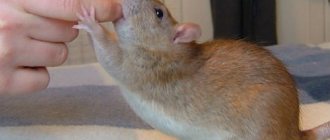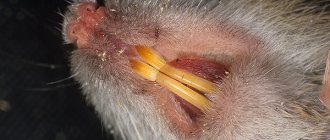Sometimes it happens that a rat has escaped from its cage. The animal can also get lost in the room when it is let out for a walk. As a rule, this happens with a young rat or an adult that has found itself in a new space.
A rat's escape can cause big problems - not only for the owner, but also for the pet itself. The animal may die, for example, by getting stuck between a cabinet and the floor. At first, until the rat gets comfortable at home, you need to keep an eye on it. Before placing an animal in your home, you need to prepare the following:
- put electrical wires into corrugated tubes,
- seal the cracks in the floor,
- free up as much space as possible so that the pet can be easily found if it runs away.
Why does a rat escape from its cage?
No owner is immune from the escape of a beloved pet. Animals have different personalities - you probably have a tireless researcher who wants to explore every nook and cranny of the apartment.
Escape from the cell can also occur for another reason - due to stress. Tamed rats know how to empathize, feel sorry for their owner when he is sad, and even drink away his tears.
But small rodents also need support. If you just bought a pet or moved with it to a new apartment, be extremely careful and attentive.
A frightened animal may hide in a hard-to-reach place if it does not feel safe in its house.
Taming a little rat
After a couple of days of rest and relaxation in their new home, you can begin to bond with your little rat. Let your new friend come to you on his own. It is very important not to force the baby rat out of the cage, otherwise you will lose his trust. When you try to call your pet, he will be very careful. This behavior is normal for them, so be patient. You should introduce yourself to your baby slowly, step by step. The best way to do this is to lure or call the baby rat to the cage door and to your hand.
Treats will help lure your little rat out of the house. Snackable treats are the best way to gain your little rat's trust. As time passes and with all the treats you give your pet, your little rat will begin to trust you and will try to leave the cage on its own in your presence. You should give your rats store-bought treats, such as dried fruits and nuts, or rat-safe homemade treats.
In general, taming a baby rat will take much less time than gaining the trust of an adult rat. The main thing is to be careful and have patience.
How to find an escaped rat in an apartment?
Escape from a cage is a headache for the owner. Therefore, it is better to prevent a problem than to solve it later. The first time after moving, it is better to darken the cage - just put the old clothes you wore on it.
Under natural conditions, animals prefer dark burrows hidden from prying eyes. With this simple trick, the rat will quickly get used to the new environment and your smell.
However, even the most attentive and caring owners may encounter the escape of their pet. The main thing is not to panic. The success of the operation to return the rodent to its home depends on your confident, calm and timely actions.
Favorite places for a rat to hide
If you are just preparing for the first meeting of a new tenant, then you need to prepare thoroughly. It's not just about a darkened cage and suitable food. Now is the time to fix holes in the floor or walls that you've never gotten around to.
Keep it clean and tidy; scattered things not only make your home look unkempt, but are also good for hiding. After inconsolable searches in the most unusual places, you may suddenly find an animal among them.
Experienced owners advise looking at your apartment through the eyes of a rodent. What secluded place will you choose in case of danger if you are the size of your palm?
You need to start the search operation from your pets’ favorite places:
- Between the wall and furniture.
- In newspapers and magazines.
- In plastic bags.
- In the closet with clothes.
Do not forget that the choice of place often depends on the nature of the animal and its habits. If a decorative rat fearlessly crawls under the ceiling with the grace of a circus performer, then first of all check the mezzanines and upper shelves of the closet.
Calm lovers of cozy houses can be found between the pillows in the bed or on the sofa. Knowing the character of the animal, catching a domestic rat will not be difficult.
Stringed instrument"
A peculiar device when a rat is caught on a string. It is believed that the rat will not be able to bite or tear it apart. A fishing hook (No. 4 or even No. 5) is attached to a steel thread. The bait (skin of fried lard, top) is strung on it. The string is attached at the entrance to the burrow or in another place. The technology of the method: grabbing an appetizing bait, the rat “strings” itself onto a sharp hook.
Another method involves using the guitar (sixth) string. A hook of the same size is tied to it. The other end can be attached to the riser. The same bait is still on the hook. To make the lard smell better, the skin can be fried over a fire. A rodent caught on a hook breaks the string. The sound it makes is an alarm signal for other rats. In theory, they should no longer appear in this place.
If you don't want to be on a string, try a traditional mouse trap
How not to harm an animal?
During the search, it is important not to harm the defenseless pet, so be extremely careful. First of all, analyze what dangers a rodent may encounter in the apartment.
Turn off all electrical appliances and the stove, remove hot food, cover pots of water and the toilet lid. Move furniture with caution, as any sudden movement can cause pain to your pet or even cause its death.
Check each item before sitting or standing on it.
You can harm the animal even after the fugitive is found. Sometimes the owners grab the animal by the tail and hold it upside down. This behavior is unacceptable. The rodent will be comfortable if you carefully take it by the body, place it in your palm, and then take it to the cage.
Search algorithm
When unplanned events happen, it can be easy to feel lost. What to do if the rat runs away and you suddenly find an empty cage?
- The most important thing is to calm down. Think about where in the apartment the baby could get hurt, immediately turn off electrical appliances and hide anything that could burn him.
- Limit your search area. Close doors and windows carefully.
- Check out your pet's favorite spots.
- Continue searching in places that may interest the animal. Decorative rats, of course, are not chameleons, but rodents are excellent at “merging” with surrounding objects. The owners note that sometimes they can be detected only by touch - they can camouflage themselves so professionally.
- Listen carefully to every sound. Turn off the TV and radio, let the silence in the apartment be ideal during the search. There was a rustling sound - immediately look for the source of the sound.
Tips and tricks
To prevent mice, and especially rats, from getting into the house, you need to create unfavorable conditions to increase their population. This means keeping living, livestock and storage areas in perfect order. Food and fodder supplies must be stored in specially designated areas. Do not litter the local area with dry branches, leaves and other debris, as this is an ideal breeding ground for rats.
Important point! No house will have a rodent if the foundation is laid to a depth of 70 cm or more and there is no space under the floor. Ventilation, sewer and other openings are covered with special metal mesh.
How to quickly catch a decorative rat?
Regular searches can take a long time and be fruitless. There are other ways to detect a traveler - experienced hosts offer many options.
Call by name
Taming a decorative rat will not be difficult. A warm attitude is important. Give him a nickname right away and teach him the name - during feeding, repeat it affectionately over and over again. Soon the rodent will react immediately to familiar sounds by running out to you. This pet skill will work in your favor if the rat goes on the run.
Lure with a tasty treat
If the pet does not respond to its name, then you can try another effective method. Remember the fairy tale about Hansel and Gretel, who were looking for their way home with the help of bread crumbs? Try catching your favorite rodent in your apartment using this method. Lay out a trail of your favorite treats and watch carefully to see if the fugitive comes out of hiding.
Place a cage nearby
After a long walk and new impressions, the pet will sooner or later get hungry. If you find a place where a rodent is hiding, but you can’t get it out yourself, then you can move the cage with treats inside. Keep an eye on the rat from its hiding place so as not to scare away the brave traveler.
Important! The food in the cage must be liquid, otherwise the pet may grab the treat and run away from the house again.
Using a bucket
If the usual methods do not work, then you can adopt unusual ideas. The ingenuity of rodent owners is enviable. Many ways have been invented to catch a pet rat using a bucket; the activity is easy to carry out at home. For example, you can place a ruler on the edge of a stool and secure it.
The other edge is pulled forward over the bucket and a small bait is placed on it. The rat follows the smell and runs down. It is important that the pet is not injured if it falls, so you need to put something soft and bulky at the bottom of the bucket.
Traps
Ancient devices that mercilessly destroy large rodents. Designs are constantly being improved, but the principle of operation does not change - lure, destroy.
Classic fixture
Effective rat repellents - metal structures with sharp edges and a springy mechanism are used in non-residential premises, garages, barns, and dachas. Bait is placed inside, or simply placed in places where pests move. The animal puts its paw inside, the trap slams shut, and the sharp edges kill the animal or cause fatal injury.
On a note!
The rat is lured into a trap with raw meat, smoked lard, and fish.
Modern trap
A trap made from an adhesive substance is more convenient to use. It is not difficult to catch a pest using glue. It is enough to install indoors and securely fix it.
Pest control traps
The preparation is applied to a surface made of plywood, durable oilcloth, or plastic. The treated base for catching rats should be about 1 sq.m. It must be nailed or self-tapping screws. Rats are quite strong animals, capable of dragging a structure with them.
Catching a rat with a glue trap is quite simple. A bait with a strong aroma is placed in the center. The smell attracts rodents. The rat tries to get to the food, sticks with its paws and fur. When trying to get out, more people fall into the trap.
On a note!
The advantage of a modern glue trap is that you can catch several rats at once. The disadvantage is the torture of animals.
The animal squeals, squeaks, and groans for a long time until it dies of hunger. This takes about 5 days. Rodent repellent glue does not dry for 14 days and is capable of sticking pests tightly.











